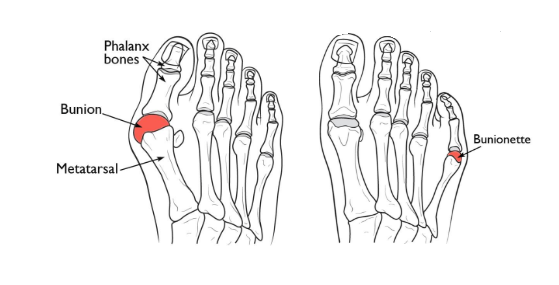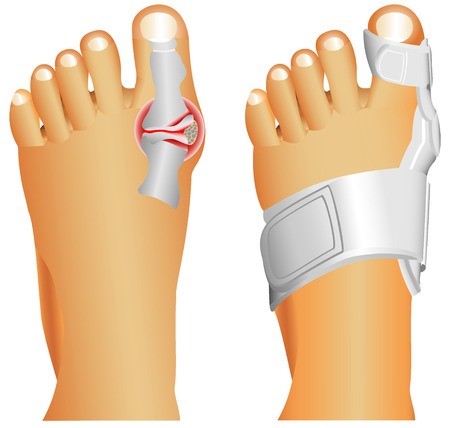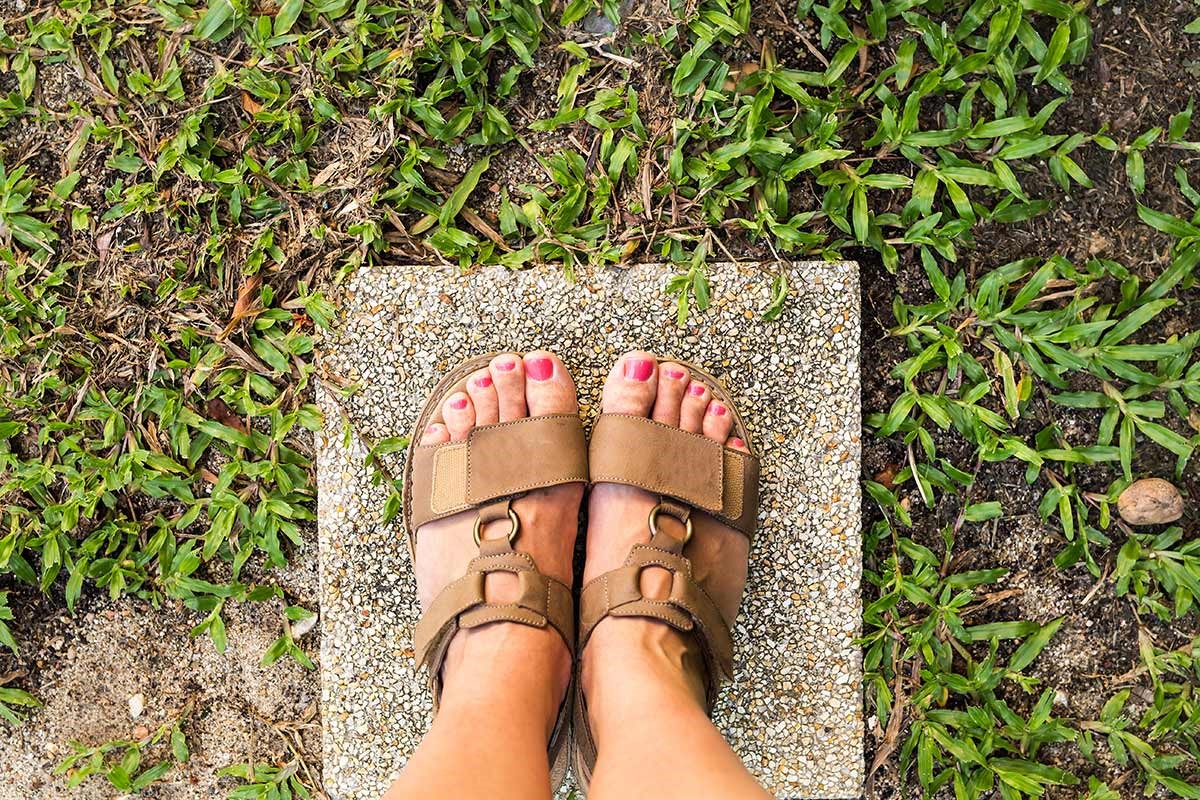Bunions - what they are and how to treat and prevent them
Bunions can gravely affect our lives and even result in other health complications such as walking difficulties, so we’ve looked at the best bunion treatments and prevention and gathered them for you in this article!
Written by stannah
Did you know that together, your foot and ankle have 26 bones, 33 joints and more than 100 muscles, tendons and ligaments? It almost sounds unbelievable that it all fits into such a small part of our bodies! And have you ever stopped to think about the impact our feet have on our quality of life? According to the Cleveland Clinic we will walk the equivalent of four times around the world during our lifetime. It’s therefore only logical that about 3/4 of Americans will eventually experience foot or ankle issues.

We all know the term “bunion” and maybe even have them, but we might be ashamed to talk about them. If that’s your case, you’re not alone. Our feet give us stability and are a big factor in keeping us balanced. They therefore help prevent us from feeling “wobbly” and even from falling.
From our research, we can tell that foot disorders are one of the main factors when it comes to causing disability and a sedentary lifestyle. This is especially true for older women, as although men can also get bunions, they affect women on a much larger scale. A foot disability such as a bunion can drastically affect our quality of life and even interfere with our daily routines and physical activity.
All these reasons are what prompted us to take a more in-depth look at what a bunion is, what causes them and what you can do about them. Before you join us on our journey into the world of foot care, we can’t stress enough that you should always consult your physician if you think you’re getting a bunion or any other kind of health problem and should avoid self-medication.
Foot disorders: All about bunions
What is a bunion? Symptoms, causes and treatments.
What causes a bunion?
What are the symptoms of a bunion?
Bunion treatments
What are the consequences of an untreated bunion?
Can we prevent or reverse bunions?
Foot disorders: All about bunions
Foot disorders are a serious concern as they can cause serious discomfort, pain, lessen quality of life and even have a major influence on your balance – which means you’re much more likely to fall. It’s time to get serious about our feet!
What is a bunion? Symptoms, causes and treatments.

Source: Blausen.com staff (2014) “Medical gallery of Blausen Medical 2014“
A bunion is a deformity of the foot where the big toe moves towards the second toe, creating a bump on the outer side of the foot, right at the base of the big toe joint. However, there are several different types of bunions:
- The most common type of bunion is the (adult) bunion on the big toe, or by its official name: hallux valgus (which comes from the Latin for big toe turned away).
- A tailor’s bunion, or bunionette (sounds kind of cute but really isn’t), is a bump in the pinkie toe that forms on the outside of the foot at the base of the pinkie toe.
- An adolescent bunion is most common among girls aged 10 to 15 and is probably hereditary.
To help you understand, imagine a healthy foot squeezed into a pointy-toe shoe. Your big toe gets pushed on top of your second toe, which causes the metatarsophalangeal (MTP) joint – or the base of the big toe – to pop out of the foot, like we can see on the image below. Now, wearing pointy shoes is a common way in which bunions are caused and a reason for which they progress, but they’re not necessarily the root cause of the problem.
What causes a bunion?

Source: Orthoinfo -From the American Academy of Orthopaedic Surgeons.
Here we see a Bunion (or Hallux Valgus) and a Bunionette (or Tailor’s bunion)
There’re several factors that can cause a bunion, and although the exact cause is unclear, we’ve listed the main causes:
- Your genes
- Foot injuries
- Severe repetitive stress
- Wearing poor fitting shoes
- Having an inflammatory or neuromuscular condition
When we say your genes, we don’t mean that the bunion itself can be passed on from one generation to the other. What is hereditary and can therefore cause a bunion, is the susceptibility of your foot to develop a bunion. For example, flat feet, low arches or loose tendons and joints are all heredity and increase the risk of developing foot problems. However, it also means that if you know that you’re likely to develop a bunion because your older family members have them, you can do something to prevent them. Or if you already have a bunion, we can tell you how to treat it.
So, to what extent do poor fitting shoes contribute to the formation and progression of a bunion? There is quite a lot of controversy around the statement that high heels with pointy toes or tight-fitting shoes cause bunions. However, it is widely agreed that these sorts of shoes do contribute to the progression of bunions, as your foot is constantly held in an abnormal position. If your foot has a predisposition to develop a bunion, it’s safe to say that keeping your big toe in an incorrect position will only worsen the deformity. However, if that’s not the case, there’s nothing to indicate that wearing these types of shoes will cause a bunion to develop.
A bunion develops as a result of pressure on the joint of the hallux (or big toe), which is caused by changes in the foot’s anatomy. This results in a person shifting their weight onto the tendons and joints of the foot. People with professions where they need to stand or walk a lot, like nursing and teaching, are more likely to develop a bunion because of the severe repetitive stress our feet endure. This is also the case with ballet dancers as, as you can imagine, their feet suffer a great deal of repetitive stress.
Causes of bunions include:
- Inflammatory or neuromuscular conditions such as Gout, rheumatoid or psoriatic arthritis or polio
- Foot injuries such as soft-tissue sprains, fractures, nerve injuries, dislocations or malunited fractures.
In order to better understand our customers with arthritis, Stannah has an arthritis suit, which was developed by the Loughborough University School of Design: a suit that mimics the effects of arthritis on different parts of the body. Stannah employees have access to this suit so that they can empathise with our customers, as well as develop our stairlifts to better meet their needs. One of the feet of the suit has a bunion, which was added to mimic exactly what it feels like to have a severe bunion.
What are the symptoms of a bunion?

Source: Jointsmedicine.com
The biggest visual symptom of a bunion is, of course, the bump on the side of your foot just next to the base of your big toe. It’s a symptom that isn’t hard to miss, so people usually notice when they have a bunion. The other most common symptoms are:
- A burning sensation in your big toe and around the area
- Difficulty walking and feeling less balanced
- It’s difficult to find shoes that fit well
- Numbness in your big toe
- Your feet get tired more easily
- Red and thickened (inflamed) skin around your big toe
- When your big toe rubs against the other toes, calluses can form
Ultimately, when a bunion is forming, the part of the joint called the “bursa”, which is a sac filled with fluid that surrounds (or cushions) the joint, will get inflamed. When this happens, the entire joint will get stiff and therefore be painful. In very serious cases, the second toe could get “trapped” between the big toe and the third toe causing it to “dive” under or get “pressed” on top of the other toes. This causes what is also referred to as a “hammertoe”, as is the case with the severe example in the image above.
Bunion treatments

Source: hielspoorinfo.nl
Again, we would like to point out that you should always consult your physician if you think you’re suffering from a bunion or have any other kind of health concern, and that you should avoid self-medication.
Before looking at possible treatments, we need to establish that there are two ways a bunion can be treated: surgically and non-surgically. Unfortunately, a bunion, if not corrected by surgery, will be permanent, although there are ways to reduce discomfort and or pain and slow its progression. So that’s the good news!
Let’s take a look at the most common (non-surgical) treatments that are available for treating hallux valgus:
- Number one is simply changing your footwear. It’s important to look for a low healed shoe with a broad toe area – a shoe that really fits. We’ll take a more detailed look at the right shoe further down this article.
- Maintain a healthy weight. The more we weigh, the more pressure we place on our feet.
- Use a pad. You can protect the bunion by means of a moleskin/gel-filled pad, or so called “bunion-shield” – padding that can be bought at a pharmacy/drugstore. Ensure your shoe is large enough to accommodate the padding.
- Using orthoses (aka shoe-inserts). A shoe insert can help in positioning your foot correctly and help to take the pressure off the bunion. When prescribed by your doctor, these will be made to measure your foot, but it’s also possible to buy them over-the-counter.
- Splints and toe spacers. Toe spacers can be used between your big toe and your second toe in order to provide relief and to straighten out your toes. Splints that can be used at night are also a common bunion tool and may help in reducing pain and in providing more comfort. A splint won’t reverse a bunion, although it will help in stopping the bunion from getting worse. (see the image above for an example of a bunion splint).
- Non-steroidal anti-inflammatory drugs. Drugs like Ibuprofen, aspirin and naproxen can help with reducing the pain and or swelling.
- Warm soaks, massages and icing. Massages, ultrasounds and or whirlpool can all help with a painful or irritated bunion. The same goes for a comfortable warm-soak or, to reduce the swelling, icing or placing ice-packs onto your bunion (but never directly onto your skin).
- Cortisone injections. This is rather extreme and will only provide temporary pain relief due as the injections reducing the swelling. The injections do, however, have many negative side effects and should not be taken lightly.
Toe exercises. Sometimes toe exercises can also help to reduce pain and prevent your bunion from progressing. You can either do this with your doctor or in your own home. These help by strengthening the muscles in your foot, like what you would do in physiotherapy. Take a look at the video below to see an example:
The only way to remove a bunion is surgically, although doctors advise that you should only do that as a last resort – only if you’ve had pain for over a year or if the bunion has progressed to such an extent that it’s causing other problems such as:
- Making you lose your balance
- Making it difficult to walk
- Hammertoes
- Bursitis
When a bunion is removed surgically, the goal is to bring the big toe back to its original position. The bones, ligaments, tendons and nerves are set back into the correct order and the bump is removed. Placing pins and/or screws to keep everything in place could be necessary, depending on the severity of the bunion. When an osteotomy is necessary it means that the doctor is going to cut and reposition the bone.
Surgery may seem like the best option, since a bunion has so many negative effects, so why do doctors only advise it as a last resort? And why do they insist on trying non-surgical treatments first? What are the most common consequences of surgery on bunions? Let’s take a look:
- It’s not guaranteed that surgery will get rid of all your symptoms, especially when we’re talking about an “adolescent bunion”. That means the person hasn’t reached skeletal maturity and therefore the chance that the bunion will return is much bigger.
- Complete recovery can take longer than a year and you need to be off your feet for at least 6 weeks or longer.
- It’s probable that the person will need to wear special shoes for some time and could need to use crutches.
Surgery for cosmetic reasons is really not recommend on hallux valgus due to the consequences listed above. Furthermore, complications such as stiffness of the big toe joint, failure of the bone to fully heal and nerve injury aren’t common but do occur.
Be sure to really think it over with your doctor if you do need/decide to have your bunion surgically removed.
Did you know? The word “bunion” comes from the Greek word “turnip” because the bump is often inflamed and becomes red and swollen-looking – like a turnip!
What are the consequences of an untreated bunion?
If a progressive bunion goes untreated it can lead to serious consequences. In a lot of cases, simply being more careful with your footwear can help stop the bunion from getting worse. And remember, if it doesn’t cause you pain and discomfort, your bunion is fine. However, if nothing is done, for example if you keep wearing ill-fitting shoes and the bunion does get worse, it could have a big negative impact on your life.
In severe cases, your second toe could get stuck and grow upwards, as we’ve mentioned before, but you may also get other problems with your feet over time, because your gait pattern will be disturbed. The worse your bunion gets; the more difficult and painful walking will become. This may result in you feeling less confident, less stable and wobblier, which can result in a loss of balance and create a negative domino effect such as serious injuries as a result of falls.
The main consequences of untreated bunions are:
- They seriously impair the foot’s function
- They can damage the other toes forming for example hammertoes
- They can lead to ingrown toenails
- They create difficulties in exercising and walking
- They can cause calluses on the bottom of your feet
- They seriously impair the way in which your feet function
- They damage your other toes, forming hammertoes and other problems
- They lead to a loss of balance, which increase your chances of fall-related injuries
- They create discomfort in the ball of your foot because you’re constantly shifting your weight off your big toe
- Difficulties in exercising and walking
- Loss of balance which broadens the chance for fall related injuries

Can we prevent or reverse bunions?
As we’ve already seen, non-surgical treatment cannot reverse a bunion. You can, however, reduce pain and prevent your bunion from getting worse.
Did you know? Women can develop bunions during pregnancy, as hormonal changes can loosen their ligaments and flatten their feet.
When it comes to preventing a bunion, if you know that you’re prone to bunions or if you start noticing the beginnings of a bunion, you can take preventive measures to keep it from developing. Taking care of your feet, especially when you’re younger, can be very beneficial as we get older. Some of the preventive measures you can take are the following:
- Exercise your feet to strengthen them (see non-surgical treatments above). Try picking up a marble or other small objects with your toes, for example.
- Avoid wearing pointy shoes or shoes that pinch your feet. If you do wear them, make sure it’s only for a couple of hours and always take a spare set of comfy shoes with you!
- Be sure to check your feet from time to time – if you keep track of their shape, you’ll notice sooner if a bunion is developing.
- Go and see your doctor or a podiatrist.
What shoes should you look for to keep your feet bunion-free?

Remember to take good care of your feet – we take them for granted when we’re younger but imagine your life without healthy feet!
“Our feet are our body’s connection to the earth” Andrew Weil
Sources:
- American Academy of Orthopaedic Surgeons
- Harvard Health Publishing – What to do about bunions
- Cleveland Clinic
You might also like:
Knee pain: know the symptoms, causes and prevention measures
Too tired to enjoy your twilight years?
Laughter is the best medicine
